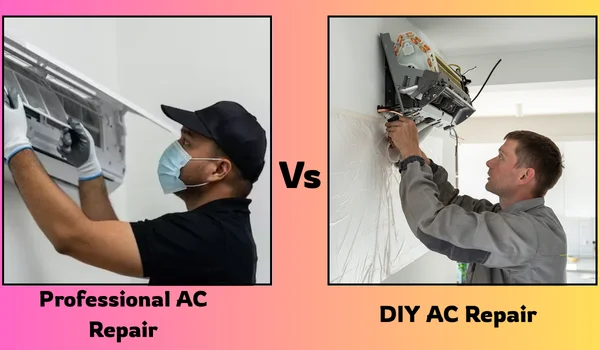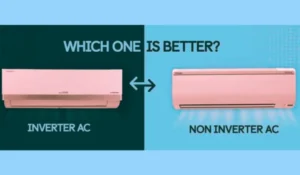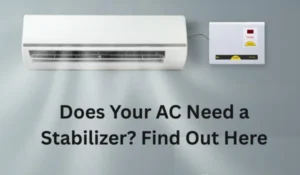As someone who has been working with electronics, appliances, and HVAC systems for over a decade, one of the most common questions I get asked is:
“Can I repair my AC myself, or should I call a professional?”
To be honest, I’ve been on both sides of this — I’ve done my fair share of DIY repairs, and I’ve also worked alongside certified AC technicians. Over the years, I’ve learned that each approach has its advantages and limitations.
So, if your air conditioner is leaking water, not cooling properly, or making strange noises, this article will help you decide whether to roll up your sleeves or dial a pro.
Let’s break it down.

My Experience With DIY AC Repair
The first time I tried fixing my own AC was a few summers ago when my split AC suddenly stopped cooling. The technician quoted ₹1,200 just for a visit, so I thought: “Why not open it up and check for myself?”
Armed with a screwdriver, a multimeter, and Google, I began investigating. The issue turned out to be a faulty capacitor in the outdoor unit. I replaced it for just ₹250, and the AC was back in action!
Since then, I’ve fixed:
- Blocked drainage pipes
- Clogged filters
- Fan motor lubrication
- Loose wiring
- Thermostat sensor alignment
But I’ve also had failures — once I messed with the refrigerant coil (not recommended), and it ended up costing me more to fix.
Pros of DIY AC Repair
1. Cost Savings
No technician fees. I once fixed a clogged drain line using a small pipe-cleaning pump worth ₹150. A professional would’ve charged ₹800+.
2. Immediate Action
You don’t have to wait for a technician. AC problems during peak summer can mean a 2–3 day wait.
3. Learning Opportunity
If you’re tech-savvy like me, AC repair teaches you valuable skills about thermostats, sensors, cooling coils, and compressors.
4. Minor Fixes Are Easy
Simple issues like dirty filters, a tripped MCB, or loose wiring can be solved in under 30 minutes.
Cons of DIY AC Repair
1. Risk of Electrical Shock
ACs deal with high voltage. If you don’t know what you’re doing, there’s a real safety hazard.
2. Voiding Warranty
Opening the unit may void your warranty, especially for newer models. I voided my LG inverter AC warranty in the second year by opening the PCB casing.
3. Lack of Tools
Most DIYers don’t have a refrigerant pressure gauge, vacuum pump, or leak detector — essential tools for diagnosing gas or compressor issues.
4. Limited to Minor Issues
DIY works for basic problems — not for refrigerant leaks, gas recharges, or PCB failures.
My Experience With Professional AC Repair
Sometimes, DIY just doesn’t cut it.
One time, my inverter AC kept showing an error code “CH38” and shutting down. I tried troubleshooting it but couldn’t pinpoint the issue. A technician came, diagnosed a refrigerant leak, vacuumed the system, recharged the gas (R-32), and sealed the leak — all in under 2 hours.
Another time, I hired a pro to replace a faulty PCB board. He tested it with his multimeter, found a burned circuit, and replaced it with an original one.
Pros of Professional AC Repair
1. Expertise and Experience
Trained technicians can quickly diagnose problems you might spend hours guessing. They’ve seen all kinds of issues.
2. Proper Equipment
Professionals come with vacuum pumps, refrigerant tanks, manifold gauges, insulation testers, and more — essential for serious repairs.
3. Warranty on Work
Most good service providers give you a warranty of 30–90 days on their work. That’s peace of mind.
4. Complex Repairs
PCB failures, compressor issues, inverter board replacement — these need technical skills and tools that DIYers don’t have.
Cons of Professional AC Repair
1. Cost
Let’s be honest — professional AC servicing in India can be expensive. A single visit might cost ₹500–₹1,500, excluding parts.
2. Wait Time
In peak season (April–June), you may have to wait 1–3 days for a technician.
3. Hit-or-Miss Service
Not all service providers are equal. I’ve had good experiences with brands like Urban Company and official LG support, but I’ve also encountered technicians who misdiagnosed the issue or overcharged for parts.
DIY vs Professional: Which One Should You Choose?
| Situation | Go DIY | Call a Pro |
|---|---|---|
| Dirty filters | ✅ Yes | ❌ No |
| Drain pipe clogged | ✅ Yes | ❌ No |
| Cooling issues without error code | ⚠️ Maybe | ✅ Recommended |
| Gas leakage or recharge | ❌ No | ✅ Yes |
| PCB board issues | ❌ No | ✅ Yes |
| Thermostat sensor alignment | ✅ Yes | ❌ No |
| Electrical buzzing sound | ⚠️ Maybe | ✅ Recommended |
| Compressor not running | ❌ No | ✅ Yes |
Safety Tips for DIY Repairs
- Always switch off the power before opening any part of the AC.
- Use insulated screwdrivers and gloves.
- Don’t attempt gas recharging or compressor fixes.
- Watch a YouTube video or refer to the brand manual before attempting.
- If you smell burning or see sparks, shut down immediately and call a professional.
Final Thoughts
In my experience, a balanced approach works best.
- For routine maintenance, filter cleaning, and small fixes — go the DIY route.
- For major problems like gas leaks, compressor failures, or electrical issues — hire a professional.
Over the years, knowing when to step back and let a certified technician take over has saved me time, money, and stress.
So before diving into your AC with a screwdriver, ask yourself — “Is this really worth the risk?” If yes, go ahead. If not, call a pro.



